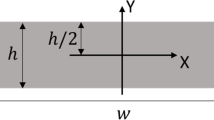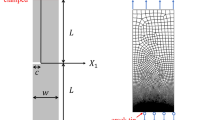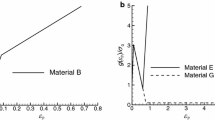Abstract
Rice, Drugan, and Sham have recently presented a discussion on the elastic-plastic stress and deformation fields at the tip of a crack growing in an ideally plastic solid under plane strain small-scale yielding conditions. Coupling their asymptotic analysis results with a crack tip opening angle criterion which requires that a constant angle 0 (measured at a characteristic distancer m behind the tip) be maintained, leads to a differential equation describing crack growth:
wherec = crack length, σo = yield strength,E = Young's modulus, andJ denotes the far-field value of theJ integral: (1 − ν2)K 2/E for small-scale yielding conditions, where ν = Poisson's ratio. The asymptotic analysis thatβ = 5.08 (for ν = 0.3), but does not give the values of the parameters α andR. However, comparisons with finite element results suggest that α has approximately the same value for stationary and growing cracks, whileR scales approximately with the plastic zone size. For large-scale yielding, Rice, Drugan, and Sham argue that a similar growth equation is expected to apply with possible variations in α and β at least in cases which maintain triaxial constraint at the crack tip. They speculate thatR increases linearly withJ at first, but then saturates in the general yield state at some fraction of the dimension of the uncracked ligament. The present paper analyses the highly idealized Dugdale-Bilby-Cottrell-Swinden model of a growing crack tip, and the results provide support for the speculations regarding the magnitude ofR in the large-scale plasticity and general yield states.
Résumé
Rice, Drugan et Sham ont présenté récemment une discussion sur les champs de contrainte et de déformation élastoplastique à l'extrémité d'une fissure en croissance dans un solide idéalement plastique sous l'effet de condition d'état plan de déformation et d'écoulement plastique à petite échelle. En couplant leur résultat d'analyse asymptotique avec le critère d'angle d'ouverture de l'extrémité de la fissure, qui requiert qu'un angle constant θ, mesuré à une distance caractéristiqueRm derrière les fissures, soit maintenu, on est conduit à une équation différentielle décrivant la croissance de la fissure. Dans cette équation,C est la longueur de fissure, σo la charge de limite élastique,E le module de Young etJ dénote la valeur de l'intégraleJ dans le champ lointain. L'analyse asymptotique montre queβ = 5,08 (pour un module de Poisson = 0,3) mais ne fournit pas les valeurs des paramètres α etR. Cependant, des comparaisons avec des résultats obtenus par éléments finis montrent que α a environ la même valeur pour des fissures stationaires et des fissures en croissance,, tandis queR s'échelonne approximativement en fonction de la dimension de la zone plastique. Dans le cas d'un écoulement plastique à grande échelle, Rice, Drugan et Sham avancent qu'une équation similaire pour la croissance d'une fissure peut être attendue pour tenir compte des variations possibles de etβ tout au moins dans les cas où se maintient un bridage triaxial à l'extrémité de la fissure. Ils estiment queR s'accroit linéairement avecJ en début puis se stabilise au cours de la plastification généralisée à une certaine fraction de la dimension du ligament non fissuré. Le présent mémoire analyse le modèle hautement idéalisé de Dugdale-Bilby-Cottrell-Swinden applicable à l'extrémité d'une fissure en croissance et les résultats apportent un soutien aux hypothèses concernant la grandeur deR dans les états de plastification à grande échelle et de plastification généralisée.
Similar content being viewed by others
References
J.R. Rice and E.P. Sorensen,Journal of the Mechanics and Physics of Solids 26 (1978) 163.
J.R. Rice, W.J. Drugan and T-L. Sham,Proceedings of Twelfth National Symposium on Fracture Mechanics, ASTM Special Technical Publication 700 (1980) 189.
D.S. Dugdale,Journal of Mechanics and Physics of Solids 8 (1960) 100.
B.A. Bilby, A.H. Cottrell and K.H. Swinden,Proceedings of the Royal Society A 272 (1963) 304.
J.R. Rice, Discussion to Reference [2].
M.P. Wnuk,Proceedings of Conference on Dynamic Crack Propagation, Ed. G.C. Sib, Lehigh University, PA, USA, Noordhoff (1973) 273.
M.P. Wnuk,International Journal of Fracture 15 (1979) 553–581.
E. Smith, Journal of Engineering Materials and Technology 103 (1981) 148.
B.A. Bilby, A.H. Cottrell, E. Smith and K.H. Swinden,Proceedings of the Royal Society A 279 (1964) 1.
P.C. Paris, H. Tada, A. Zahoor and H. Ernst,Elastic Plastic Fracture Symposium, ASTM Special Technical Publication 668 (1979) 5.
E. Smith,International Journal of Fracture 19 (1982) 195–202.
E. Smith, Paper published inProceedings of SMIRT 6 Conference, Paris, August 1981.
J.W. Hutchinson and P.C. Paris,Elastic-Plastic Fracture Symposium, ASTM Special Technical Publication 668 (1979) 37.
E. Smith,Materials Science and Engineering 44 (1980) 205.
E. Smith, unpublished work.
Author information
Authors and Affiliations
Rights and permissions
About this article
Cite this article
Smith, E. Some comments on the geometry dependence of theJ versusc relation for plane strain crack growth. Int J Fract 22, 117–124 (1983). https://doi.org/10.1007/BF00942717
Received:
Issue Date:
DOI: https://doi.org/10.1007/BF00942717




